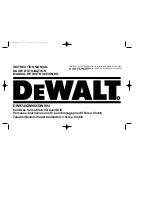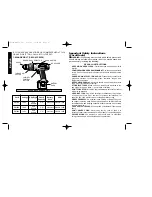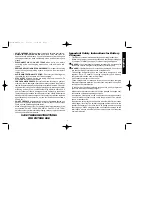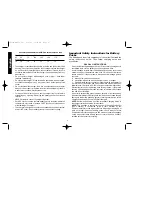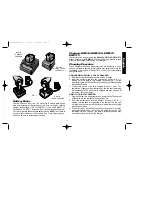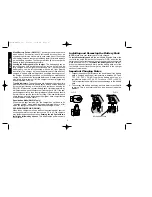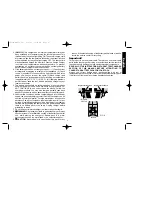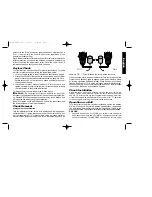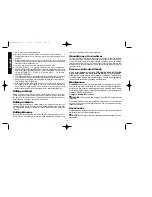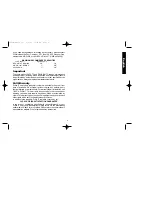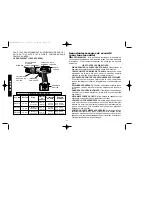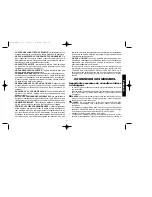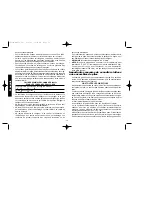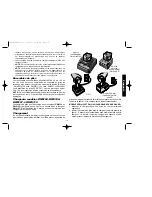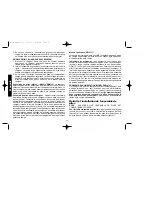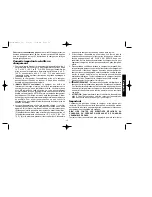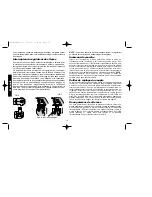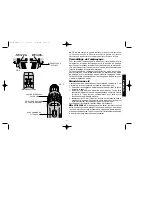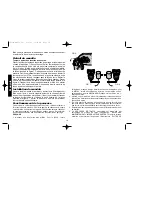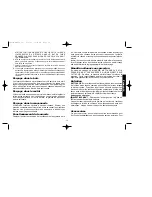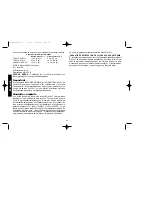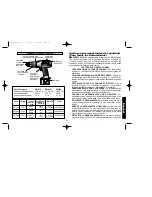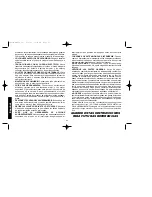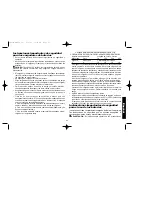
flow of dust indicates the proper drilling rate.
Operation as a Screwdriver
Turn the Driver/Drill selector to the symbol of a screw. Select the desired
speed/torque range using the dual range gear shifter on the top of tool to
match the speed and torque to the planned operation. Insert the desired
fastener accessory into the chuck as you would any drill bit. Make a few
practice runs in scrap or unseen areas to determine the proper position of
the clutch collar.
Pressure Activated Chuck
When in the screwdriving mode, THE CHUCK WILL NOT TURN
UNTIL PRESSURE IS APPLIED IN LINE WITH THE FASTENER.
Likewise, the chuck stops when pressure is released. This pressure
activated chuck feature improves accuracy of work and significantly
increases the rate at which screws can be driven.
Maintenance
CLEANING: With the motor running, blow dirt and dust out of all air
vents with dry air at least once a week. Wear safety glasses when
performing this. Exterior plastic parts may be cleaned with a damp
cloth and mild detergent. Although these parts are highly solvent
resistant, NEVER use solvents.
Charger Cleaning Instructions:
WARNING: Disconnect the charger from the AC outlet before
cleaning.
Dirt and grease may be removed from the exterior of the charger
using a cloth or soft non-metallic brush. Do not use water or any
cleaning solutions.
Accessories
Recommended accessories for use with your tool are available at
extra cost from your local service center.
CAUTION: The use of any non-recommended accessory may be
hazardous.
8
English
block, etc., use carbide-tipped bits.
2. Be sure the material to be drilled is anchored or clamped firmly. If
drilling thin material, use a “back-up” block to prevent damage to the
material.
3. Always apply pressure in a straight line with the bit. Use enough
pressure to keep the drill bit biting, but do not push hard enough to
stall the motor or deflect the bit.
4. Hold tool firmly to control the twisting action of the drill.
5. IF DRILL STALLS, it is usually because it is being overloaded.
RELEASE TRIGGER IMMEDIATELY, remove drill bit from work, and
determine cause of stalling. DO NOT CLICK TRIGGER OFF AND ON
IN AN ATTEMPT TO START A STALLED DRILL – THIS CAN
DAMAGE THE DRILL.
6. To minimize stalling or breaking through the material, reduce pressure
on drill and ease the bit through the last fractional part of the hole.
7. Keep the motor running when pulling the bit back out of a drilled hole.
This will help prevent jamming.
8. With variable speed drills there is no need to center punch the point to
be drilled. Use a slow speed to start the hole and accelerate by
squeezing the trigger harder when the hole is deep enough to drill
without the bit skipping out. Operate at full on after starting the bit.
Drilling in Wood
Holes in wood can be made with the same twist drills used for metal.
These bits may overheat unless pulled out frequently to clear chips from
the flutes. For larger holes, use low speed wood bits. Work that is likely to
splinter should be backed up with a block of wood.
Drilling in Metals
Use a cutting lubricant when drilling metals. The exceptions are cast iron
and brass which should be drilled dry. The cutting lubricants that work best
are sulphurized cutting oil or lard oil; bacon grease will also serve the
purpose.
Drilling Masonry
Use carbide tipped masonry bits at low speeds. Keep even force on the
drill but not so much that you crack the brittle materials. A smooth, even
385360/DW974 etc 5/2/02 11:25 AM Page 8


